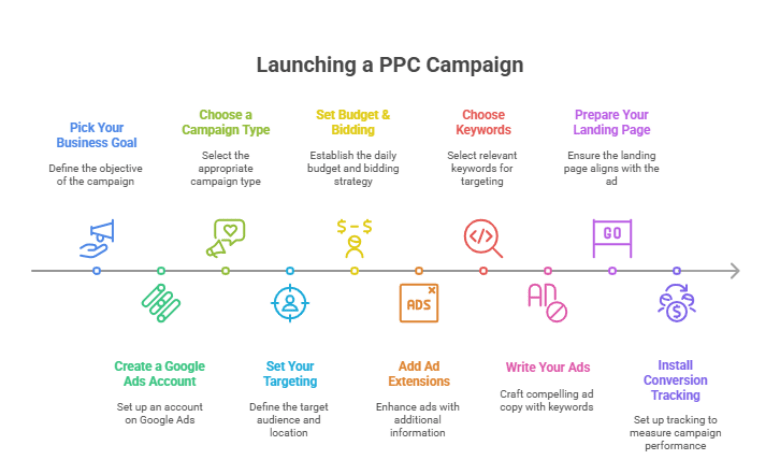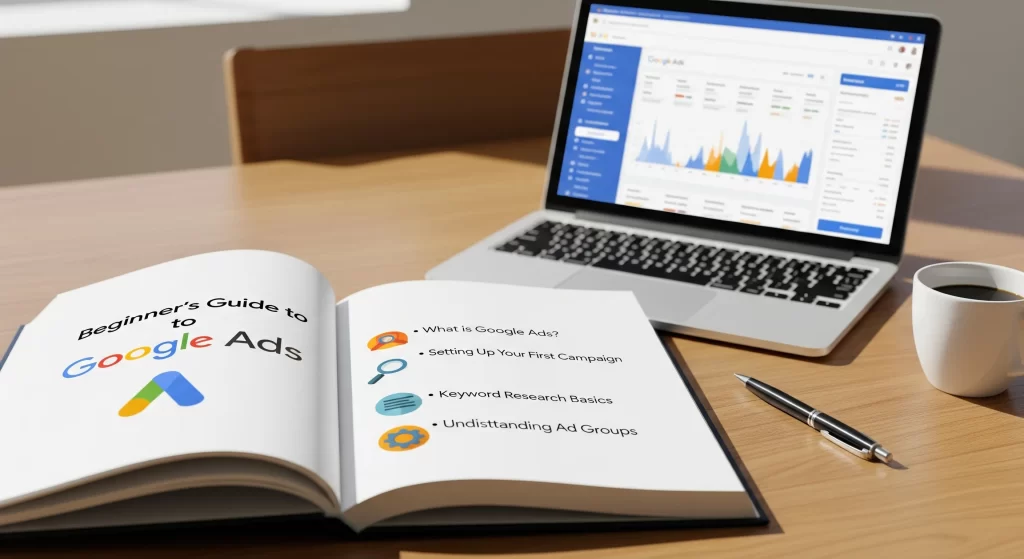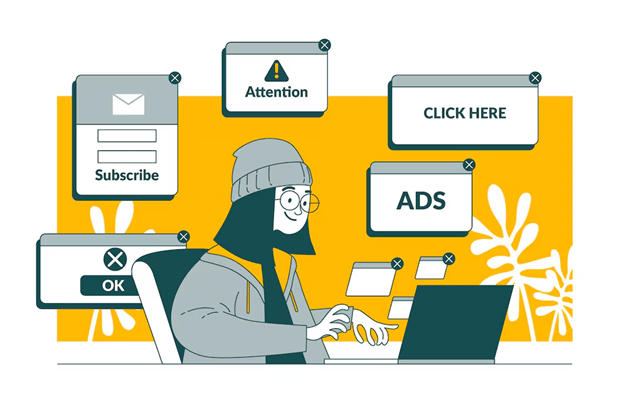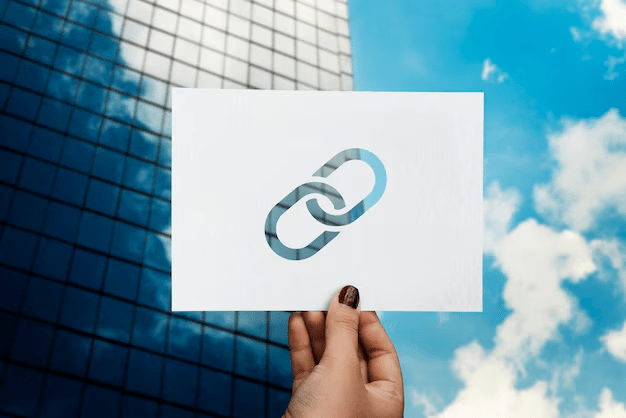This Google Ads guide is for those, who’ve never run an ad before. And the best part? Even a 4th grader can make sense of it.
This is a clear, beginner‑friendly walkthrough for PPC for beginners, offering step-by-step clarity and all the fundamentals you need, without unnecessary jargon.
If you’re new to Google advertising or paid search, you’re in the right place.
What is Google Ads, and why does it matter?
Gif showing Robert De Niro in Taxi Driver attending a rally & standing out
Google Ads is Google’s platform for paid search advertising, so a brand can stand out(like Robert De Niro did in Taxi Driver). Businesses bid on keywords people type into Google Search. When someone searches using those words, their ad might pop up at the top or bottom of the search results page.
This is known as pay‑per‑click (PPC), you pay only when someone clicks your ad, not when they see it. It’s time saving and a measurable way to attract traffic and customers(fingers crossed).
Why it matters:
- Smart targeting: Your ad shows up precisely when a person is actively searching for what you offer.
- Full control: You set a daily budget, and Google only spends it when someone clicks. You can pause your campaign any time.
- Measurable results: From clicks to leads to purchases, you see exactly what’s working, and what needs tweaking.
Is Google Ads right for me?
Google Ads is powerful because it reaches real people with real intent.
- Google handles over 9.5 million searches per minute, making it one of the world’s biggest traffic sources.
- You can hold out users who are actively looking, this is paid search marketing, where you pay only when they click, making your ad spend accountable and measurable.
- On those stats, small businesses can stretch budgets by focusing on high-converting keywords.
Campaign Types: What can I actually do with Google Ads?
In this Google Ads guide, learn about the most commonly used campaign types, each built for different goals under your Google Ads account:
Search Campaigns
Your ad appears in Google’s search results when someone types a keyword you’ve chosen. This is the heart of paid search and where the majority of beginners start.
Display Campaigns
Visual or banner ads that appear across Google’s Display Network (websites, blogs, apps). Great for brand awareness.
Video Campaigns
Ads shown before or during YouTube videos, used to reach viewers by interest or content relevance.
Shopping Campaigns
If you sell products, you can show product photos, names, and price directly in Google search results and the Shopping tab.
App Campaigns
Designed to promote mobile apps. Ads show across Google Search, Play Store, YouTube, and more.
Demand Gen Campaigns (formerly Discovery)
Visually engaging campaigns across Gmail, YouTube, and Google Discover, typically for outreach and discovery.
Performance Max Campaigns
Google optimizes across Search, Display, Video, Shopping, and more using automation. A hands-off option, but you still bring the assets and goals.
How is your account structured?
Think of your Google Ads account as a mini-organisation:
Account
├─ Campaign
│ ├─ Ad group A
│ │ ├─ Keywords
│ │ └─ Ads (text, images)
│ └─ Ad group B
└─ Campaign 2
Campaign: the big container for one advertising goal. (Example: “Summer sandals”)
Ad group: groups ads and keywords by theme. (Example: “Women’s sandals”, “Men’s sandals”)
Keywords: phrases users type to trigger your ads.
Ads: the text (or image/video) the searcher sees when they trigger a keyword.
A well-organized structure helps Google serve the most relevant ad, increases your Quality Score, and often lowers your cost-per-click.
What If I Have No Big Budget?
No worries, when starting, you can go small. Here’s what you need to do before beginning:
- A small ad budget to test (e.g. ₹500–₹1,500/day).
- A clear campaign goal: Get clicks? Leads? Orders?
- A basic website or landing page, ideally more than one page for conversion tracking.
- A Gmail account to sign up (Google Ads and Analytics 4 are free to connect).
That’s all. You’ll set the rest up step by step.
How to launch your first campaign, a 10‑step checklist

Image 1.1 Infographic showing steps of launching a PPC campaign
According to recommended best practices, here’s what your first PPC for beginners campaign looks like:
Step 1: Pick Your Business Goal
Example: Drive traffic to your call-out page, generate leads, make sales.
Step 2: Create a Google Ads Account
Visit ads.google.com, use your Google login, and enter billing info.
Step 3: Choose a Campaign Type
Most beginners start with a Search Campaign for high-intent performance.
Step 4: Set Your Targeting
Focus on location (e.g. city or country) and language (e.g. English, Hindi).
Step 5: Set Budget & Bidding
Daily budget and simple bidding like “Max CPC” to begin.
Step 6: Add Ad Extensions
Extra links or info, like call buttons or location, with your ads.
Step 7: Choose Keywords
Use Google Keyword Planner to pick 10–15 phrases that match your offer. Consider match types (broad, phrase, exact) to control when your ads show.
Step 8: Write Your Ads
Clear headline + benefit + action. Include keywords in each ad.
Step 9: Prepare Your Landing Page
Make sure page copy matches your ad and has a clear next step for the visitor.
Step 10: Install Conversion Tracking
Use Google Analytics or Ads conversion tag so you can measure clicks, leads, or sales later.
Bonus section: Keyword basics
- A keyword is a word or phrase people type on Google (e.g. “affordable hair dryer”).
- Match types determine what searches trigger your ads (broad, phrase, exact).
- Also use negative keywords to prevent irrelevant traffic (e.g. “free” if you’re not giving away products).
An In-Depth Look On Building First Search Campaign
When you’ve moved past the basic step of launching a campaign in this Google Ads guide, it’s time to dive deeper into creating one.
Switch to Expert Mode & Define Your Campaign Goal
When setting up your Google Ads account, you’ll initially see a choice between Smart Mode and Expert Mode.
- Smart Mode is guided, but only lets you reach a few campaign types.
- Expert Mode gives you full control, which is ideal for learning and growing over time.
- Most PPC experts recommend Expert Mode because it unlocks every feature within Google advertising, including detailed targeting, bidding and tracking tools.
Inside Expert Mode, you’ll first pick a campaign objective:
- For most beginners: choose Website traffic or Leads to start, so you’re paying only for clicks that bring real value.
Choose Campaign Type: Go with Search
Following your goal, you’ll get to select a campaign type.
Choose Search Campaign – this places your ad at the upper most position on Google search results when someone searches your keywords. It’s the most effective way to start within the realm of paid search.
This is where people already know what they’re looking for—your ad appears right when they need it.
Set Up Campaign Settings
Here’s what you’ll configure next:
- Campaign name: Something logical, like “July–Salons–Leads” or “Delhi–Plumbing‑Search”. It doesn’t affect results but helps with future optimization.
- Networks: Uncheck the Display Network to begin with, stick to Search only.
- Start/End dates and Ad Schedule: Unless your business only operates on weekdays, leave as “All day / every day.”
- But if you know you get conversions mostly during office hours, schedule accordingly.
- Location targeting: Choose the area you serve (e.g. “India” or “New Delhi”).
- Select the setting “Presence: People in or regularly in your target location” to avoid irrelevant traffic from outside.
- Languages: If your website is in English, select only English. If you’re multilingual, add Gujarati, Hindi, or other languages your customers speak.
Set Budget & Decide Your Bidding Strategy
Your daily budget:
- A small campaign can start with ₹500–₹1,500/day.
- To estimate budget, check industry data and divide your monthly plan by ≈ 30.
- For example, a ₹9,000 monthly budget is ₹300/day.
Bidding options:
- Manual CPC: You set the highest amount you’re willing to pay per click. Gives you control but needs careful attention.
- Smart Bidding (automated): Google uses machine learning to decide the right bid in real-time using signals like device, location, time of day, search query etc.
- Smart Bidding options include Maximize Clicks, Maximize Conversions, and Target CPA or ROAS.
As a beginner, we’d recommend you to start with Maximize Clicks or a low target CPA (e.g. ₹200/conversion). Once data builds up, you can switch to a value-focused strategy.
Ad Groups & Keywords: Organize Your Structure
What you’ll do:
- Create 1–3 ad groups per campaign.
- Each ad group focuses on a tight theme: for example, if you’re advertising “cupcakes”, ad groups might be Keyword: ‘blue cupcakes’, Keyword: ‘chocolate cupcakes’.
Inside each ad group:
- Add 10–15 keywords, using different match types:
- Exact ([ ]): most precise, lower volume
- Phrase (” “): skirts close variants
- Broad: captures more, including synonyms
Also add negative keywords to filter waste traffic (e.g., “free”, “job”) based on your goals. These stop clutter and improve Quality Score.
Why structure matters:
- Helps Google understand your relevance, which boosts Quality Score, drives ad ranking up, while potentially lowering CPC.
Write Your First Ads (Responsive Search Ads)
Google now prefers Responsive Search Ads (RSAs), which allow multiple headlines and descriptions. Google automatically tests and shows the best-performing combination.
Ad copy best practices:
- Use 3–5 headlines of up to 30 characters each: include your main keyword, value proposition and call to action (e.g. “Call Now”, “Book Today”).
- Use 2 descriptions (up to 90 characters): highlight benefits or offers (“Custom design”, “Fast delivery”).
- Use tools like WordStream’s ad copy guide for guaranteed formats.
Add Ad Extensions (“Assets”)
These optional extras boost ad visibility and credibility, no extra cost:
- Sitelinks: extra links (e.g. “Services”, “About Us”)
- Callout extensions: short benefits (“24/7 support”, “Free shipping”)
- Structured snippets: service types or features
- Call extensions: show a phone number (great for mobile)
Adding extensions often improves click-through rate (CTR) and gives Google more context about your business.
Landing Page & Conversion Tracking
Your ad links to a landing page where your visitor can take action (sign‑up, call, buy). Make sure:
- The page copy reflects your ad.
- It loads quickly and works on mobile.
- The Call to Action is clear and upfront (e.g. a button like “Buy Now” or “Contact”).
Conversion Tracking is key to measuring:
- Use Google Ads or Google Analytics 4 to track conversions (a form fill, call, purchase).
- Link Ads + Analytics to see full behavior flow.
- Once you have conversions, you can switch to bidding for Maximize Conversions or Target CPA later.
Final Review & Go Live
Before launching, double-check:
- Campaign name and date settings
- Daily budget and bid type
- Targeting: location, languages
- Ad group and keyword structure
- Ad copy and ad extensions
- Landing page URL and conversion setup
Once everything is correct, click “Publish” to make the campaign live.
You may see warnings or policy notes, review and fix if needed. Your ads will be reviewed by Google before showing.
After Launch: What to Monitor & Do Next
What to watch in the first 3-5 days:
- Number of clicks and average CPC
- Impressions and CTR
- Conversions (with conversion rate)
Important: Don’t tweak settings every day. Allow 5 to 7 days for Google’s system to “learn” what works. Big changes too soon can disrupt that process.
After that, you can:
- Pause low-performing keywords or ads
- Add more negative keywords from the Search Terms report
- Try different ad copy to improve CTR
- Adjust budget or schedule based on performance
- Test switching to Target CPA bidding once you have enough conversions
Now comes the part where you need to put a good use of your brain.
Making your ads work smarter.
Watch the right numbers (If you were too happy about the visitors)
Don’t get fooled by clicks or impressions that don’t deliver real results. Google Ads experts stress that high-performing campaigns focus on conversions, cost per conversion (CPA), conversion rate, and return on ad spend (ROAS), not just how many people clicked your ad.
Use your Dashboard or Reports → Campaigns → Columns to add these key metrics. Month over month, compare:
- Conversion volumes (leads, sales, sign‑ups)
- CPA (how much you’re paying for each result)
- ROAS (how much you earn per ₹1/$1 spent)
If your CTR is high but a low conversion rate drags you down, the ad might be interesting, but the landing page isn’t matching the promise. Or maybe wrong people are clicking (e.g. “compare” vs. “buy”).
Improve Quality Score & ad relevance
Your Quality Score is Google’s rating (1to10) of how relevant your keyword, ad, and landing page are. A higher score lowers your Cost‑per‑Click (CPC), raises your template Ad Rank, and boosts ROI, making it critical for paid search basics in 2025.
The three pillars:
| Element | What it measures | How to improve it |
| Expected CTR | Will people click it? | Use targeted keywords, include numbers or CTA like “Get quote”, A/B test responsive ads |
| Ad Relevance | Is your ad promise matching search? | Make headlines that match the keyword (“Buy Red Shoes”) |
| Landing‑page experience | Does the page deliver quickly, make info visible? | Match landing page copy and visuals to the ad; ensure it works on mobile and loads in under 3s |
We recommend revisiting ad copy frequently, especially your headlines, descriptions and responsive combinations to keep ad relevance fresh and CTR high.
One tweak: If a keyword underperforms, reuse it with a different headline or landing page theme, and review again after 1to 2 weeks.
Use long‑tail and add negative keywords
Two big helpers for better Google Ads performance:
- Long‑tail keywords (3 to 5 words) like “budget fitness tracker India” are cheaper and more intent‑driven than short broad terms like “fitness watch”. They often lead to better conversions.
- Negative keywords tell Google which searches to exclude. For instance, if you sell paid courses, exclude terms like “free”, “PDF”, “job”, “review”. Google now allows account‑level negatives too—great to block irrelevant terms like “for sale”, “complaints” across all campaigns.
Review the Search Terms Report weekly to discover irrelevant queries so you can pause or add them to your negative list.
Build audiences, especially remarketing and in‑market segments
Not everyone buys on their first visit, Google Ads helps you bring them back:
- Link your account with Google Analytics → Go to Audience → In‑Market segments to see which audiences convert well, then apply higher bids to those groups.
- Use Remarketing Lists for Search Ads (RLSAs): duplicate a high‑performing search campaign and add a targeting remarketing list. Now you can use broader match types but show your ad only to people who visited your site before. This can capture interest in keywords that normally drain budget.
Generally, remarketing audiences need at least 1,000 people—and bigger lists (5,000–10,000+) work even better.
Bid adjustments: device, location, time
As the best digital marketing company, we stress looking into “finer details” in your Google Ads settings. You can often bid higher or lower for segments where conversions change:
- Device: desktop vs. mobile vs. tablets
- Location: city, region or country level (bid up where performance is strong; pause or reduce in lagging areas).
- Ad schedule: check what days/times drive most conversions at lowest cost per lead; exclude late nights or weekends if they underperform.
Example: If your CPAs are consistently 60% lower on weekdays 10 a.m.–2 p.m., bump bids up by 20% for that slot. Cut bids or even pause nights.
Use ad extensions (assets) to boost click rates
Extensions (now called “assets”) are free extra info under your ad. Google says they often improve CTR while improving your ad’s real estate on the Search Results page.
Useful extension types:
- Sitelinks: Link to sub‑pages (e.g. Reviews / FAQ / Pricing).
- Call extensions: Show clickable phone number (especially useful for mobile users).
- Location extensions: Show your store address or nearby places.
- Price, promotion, callout extensions: Highlight prices, sales, USPs like “24/7 support” or “Free trial”.
Once you enable them on the campaign/ad group level, Google handles the rest by showing whichever assets help.
Scale to new campaign types cautiously
At first, you likely focused on Search ads. But as you collect data and convert reliably, consider expanding:
- Performance Max campaigns: Google automatically distributes ads across Search, Display, YouTube, Gmail, Discover, and Display remarketing. This uses the audience signals and assets you’ve already set up—ideal for scaling.
- Display remarketing: Show ads with visuals to past visitors across the Google Display Network.
- Shopping or local ads: If you have product inventory or local presence.
- United strategy approach: HawkSEM and WordStream both recommend mixing campaign types to avoid dependence on a single ad format (just like having a varied menu in cooking aids nutrition and interest, mixing ad types helps reach people at many points in the customer journey).
It’s important to scale budgets slowly. When adding Performance Max, keep Search running in parallel for a test period. Compare cost per conversion and pause the weaker performer after a week.
Automate routine tasks with smart bidding and rules
Google’s “smart bidding” (like Maximize Conversions, Target CPA, Target ROAS or Value‑based bidding) uses machine learning across your conversion data to spend budget on best‑performing auctions.
But: For smart bidding to work well, track a consistent conversion (e.g. a sale or demo schedule), not a mix of softer actions. The system learns best when focused on a single bottom‑of‑funnel result.
Other ideas:
- Set automated rules, such as “if a keyword’s CTR is under 1% and CPA > ₹1,000 for 14 days, pause it”.
- Explore simple scripts (e.g. checking broken URLs, detecting no conversions for 30 days) once you’re comfortable.
A weekly + monthly optimization checklist
| Weekly (fast check) | What to look for |
| Search terms report | Pause poor queries and add as negatives |
| Low‑CTR ads or keywords | Refresh ad copy or pause |
| Grey or low conversion dates | Adjust bid or pause day/time |
| Device/location groups | Adjust those bid boosts up/down |
| Monthly (deeper audit) | Step-by-step |
| Campaign-level settings | Review Bids, Budget, Scheduling |
| Conversion tracking audit | Ensure tags/pixel working correctly – sudden drops or spikes in conversion data may indicate tracking problems. |
| Keyword cleanup | Remove costlier keywords not converting or damaging Quality Score |
| Ad copy refresh | Alter headlines or descriptions; test new CTAs |
| Extension performance | Turn off low-use assets; test others |
| Audience performance | Add new remarketing lists; adjust current bid multipliers |
| Scale-related budget transfer | If Search is stable, move 20–30% budget to Performance Max or display retargeting |
Max or display retargeting
Because most Google Ads campaigns need at least a 4–8 week learning period before holding steady, wait until then before making major bid‑strategy switches or large scaling moves.
Wrap‑Up: What you’ve done (and what’s next)
By the end of this Google Ads guide, you’ve:
- Learned to focus on meaningful metrics (not just clicks)
- Improved Quality Score by refining ads and landing pages
- Cleaned out poor queries and added focused keywords
- Used audiences and remarketing to recapture interest
- Adjusted your bids by device, location, and time to reduce waste
- Added thoughtful extensions to boost CTR
- Expanded safely into Smart / Performance Max, Display, or local
- Set automation and established routine checks to keep efficiency high
You’re now running a resilient Google Ads account built to learn, adapt, and grow over time.
If you’re looking for PPC services in India, Wildnet is your answer. With 19+ years, we’ve mastered the various nuances of Google Ads and can deliver results.
FAQs
What is Google Ads and how does it actually work?
Google Ads is a paid search or PPC for beginners tool from Google. You pick keywords your ideal customers might search for, bid how much you’re willing to pay per click, and write your ad copy. Google uses a real‑time auction (Ad Rank = bid × Quality Score) to decide when and where to show your ad. You pay only when someone clicks. It’s a key part of any Google Ads guide or Google advertising strategy.
What types of Google Ads campaigns are there, and how do I choose?
There are 7 main campaign types:
- Search: text ads on Google Search
- Display: banner/image ads across websites
- Video: ads on YouTube
- Shopping: product listings (if you run an online store)
- App: for mobile app installs or engagement
- Demand Gen (formerly Discovery): visual ads in Gmail, YouTube feed, and Discover.
- Performance Max: Google chooses placements across Search, Display, YouTube, Gmail, Maps, and more for one goal
Most businesses start with Search for high‑intent traffic and later try Performance Max once they have enough conversion data.
How much does Google Ads cost and how should I budget it?
Cost varies by industry and keyword competition. As of 2025:
- Average Search campaign CPC = $1.25‑$4.50
- Average Display CPC = under $1
- For new advertisers, a budget of $1‑5 USD per day can be enough to test and learn.
- Keep daily budgets low at first. Monitor cost per click (CPC), cost per lead (CPL), and cost per acquisition (CPA) to see if you’re getting results for your money.
What is Quality Score, and should I care?
Quality Score is a measure from 1 to 10 that shows how good your ad is.
It looks at:
- How likely people are to click your ad
- How closely your ad matches what they searched for
- How useful your website is after they click
A higher score means your ad shows up in better spots and costs less per click. It also helps you see what needs fixing.
What are keyword match types and how do they impact PPC targeting?
Match types that decide when your ads show up based on what people search for:
- Broad match shows ads on related searches, even synonyms or similar intent
- Phrase match shows ads only when the search phrase appears in sequence
- Exact match shows ads only for the exact search term
- Broad match captures more searches but can waste budget if not managed. Phrase and exact match give you tighter control. Smart bidding with broad match often delivers better results once you monitor your search reports.
How do I track conversions and measure ROI from my ads?
Set up conversion tracking to count when users take desired actions (like buying or contacting you).
Link Google Ads with Google Analytics 4 and enable enhanced conversions or offline conversion uploads.
Then monitor cost-per-conversion (CPA) and return on ad spend (ROAS), e.g. if you spend ₹1,000 and earn ₹4,000 in profit, your ROAS is 4×. Tracking helps you figure out which keywords and campaigns are truly profitable.
What are negative keywords and why should I add them?
Negative keywords are search terms where you don’t want your ads to appear, for instance, “free,” “cheap,” or irrelevant territory names.
They help:
- Reduce wasted clicks
- Lower costs
- Increase ROI
- You can add universal negative lists across campaigns. This is especially useful in PPC for beginners, helping keep ad spend focused on qualified leads.
What is automated or smart bidding, and when should I use it?
Smart bidding uses Google’s AI to set bids based on your goals. The most common strategies:
- Maximize conversions: gets the most conversions for your budget
- Target CPA: aims for a specific cost per acquisition
- Target ROAS: bids to hit a revenue return rate
Manual bidding can work when you’re just starting. As you get conversion data, switch to smart bidding. It’s a key step in advanced Google advertising strategies.
Can AI manage my campaigns automatically? Should I trust it?
Yes! Google has introduced tools like Performance Max, Smart Bidding, Veo and Imagen (for automating ad creative), some call this a “black box.” AI can save time, make real‑time decisions, and improve results. But less control and transparency concern many marketers too. For best results, start with Search + manual control, gather data, and then test AI‑driven features gradually.
What’s the best way to improve my campaigns over time?
Follow a regular optimization routine:
- Check key metrics like CTR, CPA, Quality Score, and conversion rate every 3 to 5 days
- Add high-performing search terms as keywords and low‑performing ones as negatives
- Split ad groups into tightly themed groups for relevance
- Test new ad copy often (especially headlines & CTAs)
- Refine landing pages so they mirror ad promises and load fast
- Once conversions are steady, scale top campaigns and slowly introduce Performance Max or Demand Gen for broader visibility.
Read More:







